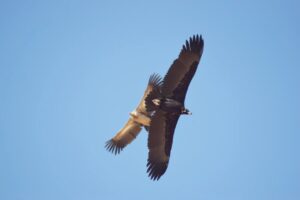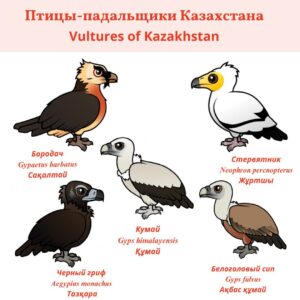ARE VETERINARY DRUGS DANGEROUS FOR WILDLIFE? WE INVESTIGATE WHY THE GRIFFON VULTURE IS VANISHING IN KAZAKHSTAN
Text by Alyona Kaptyonkina. Edited by Aliya Wedelich.
The Griffon Vulture (Gyps fulvus) belongs to the Gyps genus and is one of the largest species of vultures. The Griffon Vulture inhabits a wide range of habitats worldwide. In Kazakhstan, the main breeding area is found in the south and southeast of the country.
According to an expert assessment from a decade ago, the population of Griffon Vultures in Kazakhstan does not exceed 150 pairs. The global population is estimated to be between 80,000 and 900,000 mature individuals. Studies conducted by ornithologists from RRRCN and BRCC in the Karatau Mountains in 2010 and 2022, where the largest population of the species was, and where the largest colonies were located, show that the number of active nests has decreased by 10 folds. What has led to such a steep decline?
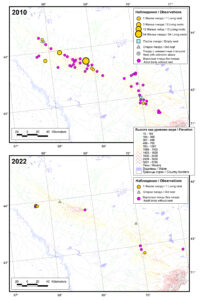
Colonies of Griffon Vultures in Karatau in 2010 and 2022. Source: Kaptyonkina et al., 2023 (in print)
THREATS FACED BY THE GRIFFON VULTURE IN OTHER COUNTRIES
Not too long ago, during the XIX-XX centuries, the main cause of the decline in the Griffon Vulture population was illegal shooting. It was the main threat to the species in most of Europe, North Africa, and the Middle East.
Currently, the most serious threats to the species are secondary poisoning by poisonous baits intended to control predators and the exposure to non-steroidal anti-inflammatory drugs used in veterinary medicine.
The other factors negatively impacting Griffon Vulture populations are:
- Lack of food due to changes in livestock management methods, making carrion inaccessible to vultures;
- Electrocution on power lines, especially relevant in densely populated areas of Spain and Portugal;
- Collisions with the blades of wind turbines;
- Lead poisoning from ammunition fragments.
Not all the listed reasons could be relevant to the Griffon vulture population in Kazakhstan. Let's examine our three main hypotheses.
HYPOTHESIS #1 – REDUCTION OF THE FOOD
Twenty years ago, scientists (Sklyarenko and his colleagues) already made assumptions about why the Griffon Vulture population is declining in Kazakhstan. Two reasons were identified at that time
- Reduction in the number of livestock and increased control by livestock breeders over their losses
- Steep reduction in the saiga antelope (Saiga tatarica) population in central Kazakhstan (Betpakdalin group), which served as a food source for a large number of immature birds.
However, in recent years, with the growth of livestock and saiga numbers, these reasons have lost relevance. The number of small cattle in the Turkistan Region (formerly South Kazakhstan Region) and Jambyl Region in recent years has reached the levels from the Soviet period, and the number of cattle and horses has exceeded its Soviet equivalent by two folds. The population of the Betpakdalin saiga, after a decline in the years 2000 to 2010, has been growing, with its unprecedented surge (more than 4.5 times) occurring in 2020 to 2023, or the pandemic and post-pandemic period.
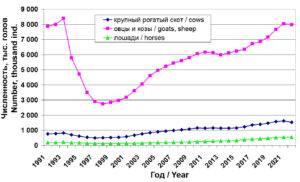
The dynamics of the livestock number in the Turkistan Region (formerly South Kazakhstan Region) and Jambyl Region of Kazakhstan from 1991 to 2022. Source: Kaptyonkina et al., 2023 (in print)
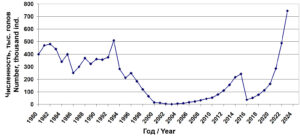
The dynamics of the Betpakdalin population of saiga antelope (Saiga tatarica) in Kazakhstan from 1980 to 2023. Source: Kaptyonkina et al., 2023 (in print)
This means that the decline in the Griffon Vulture population in Karatau occurred despite the growth of livestock and saiga numbers. With almost no measures in place for farmers to collect livestock carrion, the availability of food for vultures remains high. Therefore, we exclude the lack of food as a cause for the decline in the Griffon Vulture population and move on to testing the next hypothesis.
HYPOTHESIS #2 – POISONING
We have conducted a random public survey regarding the use of poisons to control wolves. The survey involved local residents in a number of locations which cover 20 % of vulture nesting sites in Karatau. Hunters and farmers provided oral testimonies that herders poison wolves in almost all the sites where intensive grazing is practiced. However, respondents struggled to specify which exact substances are used, describing them only as 'rat poison.' It is highly likely that such common substances in Kazakhstan as carbofuran and bromadiolone are used for bait treatment. We keep this hypothesis as quite plausible.
HYPOTHESIS #3 – EXPOSURE TO NON-STEROIDAL ANTI-INFLAMMATORY DRUGS
This hypothesis seems to us as the most likely one, especially considering the catastrophic impact of non-steroidal anti-inflammatory drugs (NSAIDs), used in livestock veterinary, on vultures. In India, Pakistan, and Nepal, in two decades (1990s-2000s), populations of four vulture species nearly vanished, with a decline of 97-99.9 %. One of the affected species was the Indian Vulture (Gyps bengalensis), once the most numerous large predatory bird in the world. The impact of veterinary NSAIDs on the Griffon Vulture and other scavengers in Kazakhstan has not been studied.
To determine which NSAIDs vets use in our country, we sent inquiries to the Veterinary Control and Supervision Committee of the Ministry of Agriculture of the Republic of Kazakhstan and the veterinary departments of the Turkistan and Jambyl regions. In response, the Veterinary Control and Supervision Committee provided a list that included diclofenac, ketoprofen, and flunixin. The negative impact of these three drugs on vultures has been proven in various countries worldwide, and they are prohibited in several Asian countries. However, in Kazakhstan, they continue to be used without any restrictions.
To shed light on the volumes of these drugs' usage, we obtained responses from the veterinary departments of the Turkistan and Zhambyl regions where the Karatau Mountains stretch. We learned that in the Turkistan Region alone up to 288 doses of ketoprofen-containing drugs and up to 253 doses of flunixin-containing drugs were used annually from 2018 to 2022. The quantity and types of drugs purchased and used by private livestock owners, bypassing veterinary pharmacies, are unknown.
It seems that the decrease in the Kazakhstan population of the Griffon Vulture started immediately after the collapse of the Soviet livestock system and the decline in saiga numbers, as Sklyarenko and his co-authors suggested in 2002. When livestock farming began to recover in independent Kazakhstan and NSAIDs started to be used in veterinary medicine, it intensified the negative trend in this vulture population.
Another assumption is that vultures nesting in Kazakhstan are poisoned during their wintering seasons in India and Pakistan. In India, despite the ban, diclofenac is still used.
What do we know about the impact of diclofenac on vultures?
This drug in the medicinal forms of sodium salt was created in 1966 and, as an anti-inflammatory agent with a powerful analgesic effect, is still widely used in many medical fields, including veterinary medicine. Before the discovery of its harmful effects on vultures, diclofenac, being a cheap substance to produce, was widely used in Asian countries to treat livestock.
In the early 2000s, scientists found that diclofenac is toxic for birds. For vultures feeding on the remains of livestock previously treated with diclofenac, this drug is a lethal nephrotoxin — it accumulates in the kidneys, causing their destruction. It has been proven that Griffon Vultures and other members of the Gyps genus, including the practically extinct Indian Vulture, are sensitive to diclofenac and the dose of diclofenac at 0.8 mg/kg is highly toxic for them.
After the collapse of Griffon Vulture populations in India and Pakistan became noticeable, studies on vulture nesting populations were initiated in most Asian countries. A similar study, funded by the Wildlife Conservation Society, was started in 2001 in Kazakhstan, too. At that time, researchers did not find 'any clear signs of diseases similar to those causing the mass die-off of vultures in India.'
RESTRICTIONS ON THE USE OF DANGEROUS NSAIDs IN DIFFERENT COUNTRIES
Diclofenac has been prohibited for use as a veterinary drug in India, Nepal, and Pakistan since 2006 and in Bangladesh since 2010. Nevertheless, residues of diclofenac continue to be found in the carcasses of cattle and vultures in these countries. In India, despite the ban, diclofenac accounted for 10-46% of all NSAIDs offered for sale for livestock treatment in 2017.
Ketoprofen was banned in Bangladesh for use as a veterinary drug in 2017, but only in vultures conservation areas. Ketoprofen and aceclofenac are entirely prohibited in India as of 2023. Meanwhile, other drugs dangerous for vultures remain permitted for veterinary use in many countries with vulture populations.
SAFE ALTERNATIVE
There is a safe alternative to wildlife-threatening NSAIDs. More than 15 years have passed since the safety of meloxicam for vultures was proven. However, it is still not used even in countries that have banned diclofenac in veterinary medicine.
HOW TO PROTECT VULTURES IN KAZAKHSTAN?
To study the role of NSAIDs in the decline of the Griffon Vulture population and other vultures in Kazakhstan, targeted research is necessary. Due to the shrunk population, finding the bodies of deceased birds for analysis may be challenging. However, only this can shed light on why we are losing vultures.
Vultures play the role of nature's sanitation, ridding ecosystems of decomposing organisms and preventing the spread of infectious diseases. Three out of the five vulture species inhabiting our country are listed in Kazakhstan's Red Book. These are the Egyptian Vulture (Neophron percnopterus), Bearded Vulture (Gypaetus barbatus), and Himalayan Griffon (Gyps himalayensis). The population of the Cinereous Vulture (Aegypius monachus), whose numbers in Kazakhstan are entirely unknown, and the Griffon Vulture are not under state protection.
The necessary and primary action for the conservation of the Griffon Vulture and Cinereous Vulture is their inclusion in the Red Book of the Republic of Kazakhstan. BRCC has already submitted this proposal to the Institute of Zoology of the Republic of Kazakhstan and, in collaboration with partners, is developing biological justifications for this.
In the study of raptors, local residents can help, too. If you have found a deceased raptor, including vultures (Bearded Vulture, Cinereous Vulture, Himalayan Griffon, Egyptian Vulture, or Griffon Vulture), you can take a photo of the finding and send it to BRCC, stating the location and date of such finding.
***
Soon, a scientific article on the results of studying the Kazakhstan population of the Griffon Vulture will be published in the journal 'Raptors Conservation.' The paper has been written by a team of authors from BRCC and RRRCN: Alyona Kaptyonkina, Igor Karyakin, Genrietta Pulikova, and Nurlan Ongarbayev.
The information campaign on threats to raptors in Kazakhstan is supported within the framework of the Biodiversity Focus in the Central Asian Mountain Region Program. This program is coordinated by WWF-Central Asia and funded by CEPF (Critical Ecosystem Partnership Fund).

